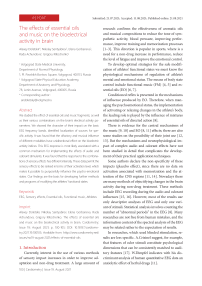The effects of essential oils and music on the bioelectrical activity in brain
Автор: Alexey Doletskii, Nikolay Sentyabrev, Elena Gorbaneva, Rada Achundova, Grigory Klitochenko
Журнал: Cardiometry @cardiometry
Статья в выпуске: 19, 2021 года.
Бесплатный доступ
We studied the effect of essential oils and music fragments, as well as their various combinations on the brain’s electrical activity parameters. We showed the character of their impact on the basic EEG frequency bands, identified localization of sources for specific activity. It was found that the olfactory and musical influence of different modalities have unidirectional effect on the bioelectric activity indices. This EEG response is most likely associated with a common mechanism for implementing the effects of audio and odorant stimulants. It was found that the response to the combinations of sensory effects has different intensity. These data permit the sensory effects to be ranked in terms of their activation level, which makes it possible to purposefully influence the psycho-emotional states. Our findings are the basis for developing further methods and programs of modifying the athletes’ functional states
EEG, Sensory effects, Essential oils, Functional music, Athletes
Короткий адрес: https://sciup.org/148320557
IDR: 148320557 | DOI: 10.18137/cardiometry.2021.19.100105
Текст научной статьи The effects of essential oils and music on the bioelectrical activity in brain
Alexey Doletskii, Nikolay Sentyabrev, Elena Gorbaneva, Rada Achundova, Grigory Klitochenko. The effects of essential oils and music on the bioelectrical activity in brain. Cardiometry; Issue 19; August 2021; p. 100-105; DOI: 10.18137/cardiome-try.2021.19.100105; Available from: issues/no19-august-2021/effects-of-essential-oils
Currently, interest in the use of various methods of sensory impact increases in order to improve adaptation and non-drug treatment. A large amount of 100 | Cardiometry | Issue 19. August 2021
research confirms the effectiveness of aromatic oils and musical compositions to reduce the tone of sympathetic activity, blood pressure, improving performance, improve training and memorization processes [1–3]. This direction is popular in sports, where is a need for a non-drug increase in performance, reduce the level of fatigue and improve the emotional control.
To develop optimal strategies for the safe modification of athletes’ functional states we must know the physiological mechanisms of regulation of athlete’s mental and emotional status. The means of body state control include functional music (FM) [4, 5] and essential oils (EO) [6, 7].
Conditioned reflex is presented in the mechanisms of influence produced by EO. Therefore, when managing the psychoemotional status, the implementation of activating or relaxing changes in the athlete’s body, the leading role is played by the influence of mixtures of essential oils of directed action [8].
There is evidence for the central mechanisms of the music [9, 10] and EO [8, 11] effects; there are also some studies on the possibility of their joint use [12, 13]. But the mechanisms and neurophysiological impact of complex audio and odorant effects have not been studied in detail that complicates the development of their practical application techniques.
Some authors declare the non-specificity of these impacts (placebo effect), since there are no data on activation associated with memorization and the attention of the CNS regions [11, 14]. Nowadays there are many methods of objectifying changes in the brain activity during non-drug treatment. These methods include EEG recording during the audio and odorant influences [15, 16]. However, most of the results use only descriptive analyses of EEG and only one variant of stimuli. Statistical analysis involves counting the number of “abnormal periods” in the EEG [8]. Many researches are not free from human mistakes, and the information content of the spectral analysis of the EEG may be related rather to the expectation of results.
In researches, which used blinded stimulation, results are less specific. A.Crisinel suggest, for example, that features of odor stimuli constitute psychological dimensions that can be consistently matched to auditory features [17]. W.Dimpfel indicates with his discriminant analysis of human quantitative EEG data an anxiolytic effect of herbal drugs [11].
There is no information about the mechanisms of the changes. In this regard, it initiates an interest in consideration of the effect of non-drug influences on the central nervous system.
The purpose of this study was to study the changes in the spectral and tomographic analysis of the bioelectric activity of the brain in response to functional music (FM) and essential oils, as well as investigate the nature of changes in the localization of the bioelectric activity of the brain under these influences.
2. Materials and Methods
The study involved 8 middle distance runners (male right-handers, aged 19 to 22 years). The subjects were exposed to some pieces of energizing (rock music) or relaxing (classical) music followed by the olfactory impacts with specially designed energizing and relaxing EO blends (EOB) through cold inhalation [7]. The specific blends were selected on the basis of some publications [7, 18] and coded by a leading researcher for the blind study. For objectification we used impacts of the same duration: five-minute exposure, three-minute rest periods between stimuli, random alternation of audio and odorant impacts, and blind method of stimuli presentation and result processing.
Musical compositions were also classified as activating (speed and power metal) and relaxing (classical music pieces).
The means of influencing the functional state of the organism by smell were aromatic compositions “calmness” and “inspiration” (Mirra-M, Russia), which had different directions of influence (relaxation for “calmness”, tonic for “inspiration”).
In this research we creating combinations of essential oils and music as follows:
• Toning oil + toning music,
• Toning music + relaxing oil,
• Relaxing music + tonic oil,
• Relaxing oil and music.
3. Results
3.1. Spectral analysis
All stages of research were managed with temporary intervals (on average 5 days) for excluding the action of addiction / fatigue factor. During the study, the laboratory was darkened, and foreign sound irritants were reduced to a minimum.
An important stage in the study was blinding. All kinds of functional music and essential oils were coded and numbered. The researcher and the subject were not aware of components of the compositions.
The EEG recordings were performed at baseline, during each sensory impact and after its completion with 19 standard bipolar leads according to the 10-20 international scheme with the Encephalan-131 electroencephalograph (Medicom-MTD, Russia). After removing the artifacts, the individual 4 sec EEG segments were processed using the spectral analysis method (fast Fourier transform algorithm, implemented in the software supplied with the electroencephalograph). Averaging the six measurement data on amplitude and spectral power reduced the influence of artifacts and individual variability. The average amplitude value was calculated in standard delta (Δ), theta (θ), alpha (α) and beta (β) bands.
Statistical processing (pairwise nonparametric analysis, multivariate analysis of variance) was performed with the R software (version 4).
To determine distributed EEG source localization, the sLoreta program was used, which involves the one-way analysis of variance to assess the significance of intergroup differences [19,20]. At p<0.05, the differences were considered significant.
The most pronounced changes in average amplitude of the bioelectric activity were detected with the parietal leads: when exposed to energizing EOB 19±11µV to 24.7±8.8 µV for Δ- rhythm and 12.2±4 to 14.3±5.3 µV for α-rhythm (hereinafter, values are given in M±σ format). However, these effects, as well as the less pronounced average data dynamics for other impact types were not statistically significant.
This fact confirms the view that the olfactory perception is connected with changes in hemispheric asymmetry of the brain bioelectrical activity in alpha and theta bands. It should also be emphasized in connection with the special role of the functional brain asymmetry in the organization and execution of complex motor activities.
3.2. EEG tomographic analysis
To identify the localization of bioelectric activity in the sLoreta program used for scientific research, a built-in mathematical algorithm was used in localization of both the surface sources (cortical) and the deep ones.
In baseline state, compared with the effect of a combination of relaxing odorant and musical stimuli, there was a significantly (p <0.05) greater activity of the beta-2 frequency range of the EEG in the right parietal region (fusiform gyrus), see Figure 1 given herein.
At the same time, isolated effects of functional music and essential oils did not cause changes in all standard frequency ranges of EEG. In the initial state, in comparison with the stimulating odorant effect, there was a significantly greater activity in the left precentral area in the delta-range of the EEG (see Figure 2 herein).
The most likely cause of the unidirectionality of the considered effects on EEG may be the common mechanisms of their implementation through the emotion-generating structures, including the activation of the limbic system and, in particular, the thalamus [21, 22]. The major changes in the EEG parameters occurred under the influence of EOB, which is determined by the close relationship of the olfaction and the limbic system.
Changes between the relaxing and the tonic essential oils blends’ exposure in alpha-2 range are localized in the Brodmann’s area 23 in the left hemisphere. This region of the brain corresponds to a part of the posterior cingulate cortex (see Figure 3 herein). This relatively poorly investigated area is a part of the limbic system, and it is involved in the emotional perception, in a set of cognitive processes with internal representations [23].
Different music types also causes changes in the localization of bioelectric potentials. Thus, tonic music produces a decrease in the activity of the theta band in the tertiary zone of the right temporal area. At the same type, a single-directed music action leads to a decrease in the activity in the delta band in the ventromedial prefrontal cortex (see Fig.4 herein). These zones are responsible for associations with the emotional reactions and the social behavior. Decreasing activity in Brodmann Area 25 (ventromedial prefrontal cortex) may lead to hypersociability and anxiety [24].
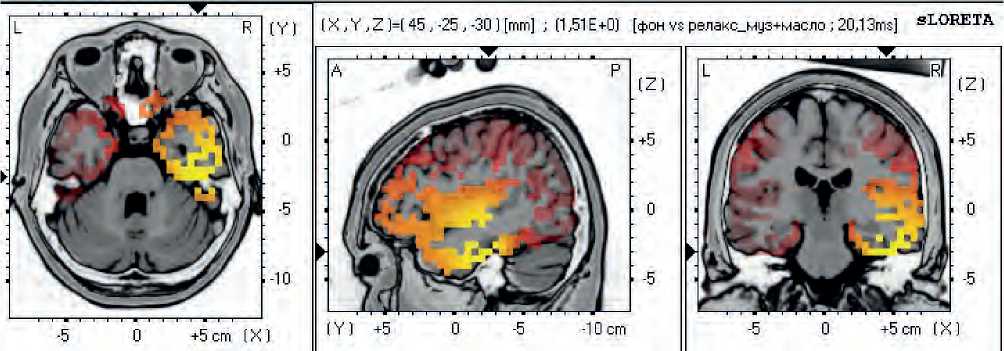
Figure 1. Difference between the background EEG and the relaxing FM + relaxing EO exposure in the beta-2 range. Here and hereinafter highlighted is a brain area which had significantly higher values of the first state in comparison with the second state in the entire study sample.
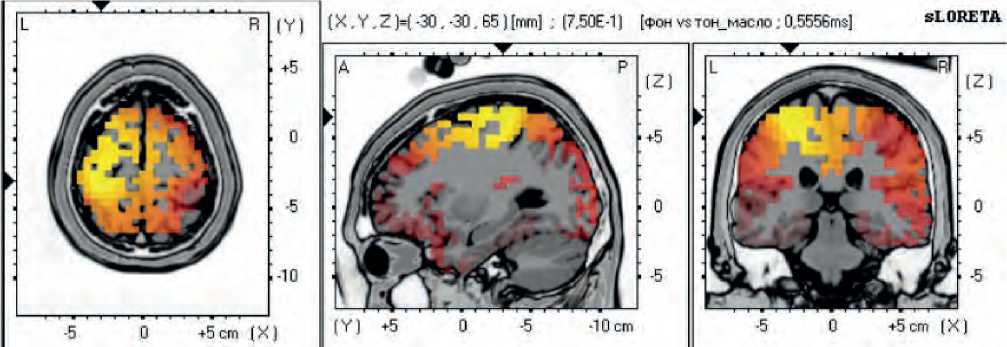
Figure 2. Difference between the background EEG and the tonic EO exposure in the delta range
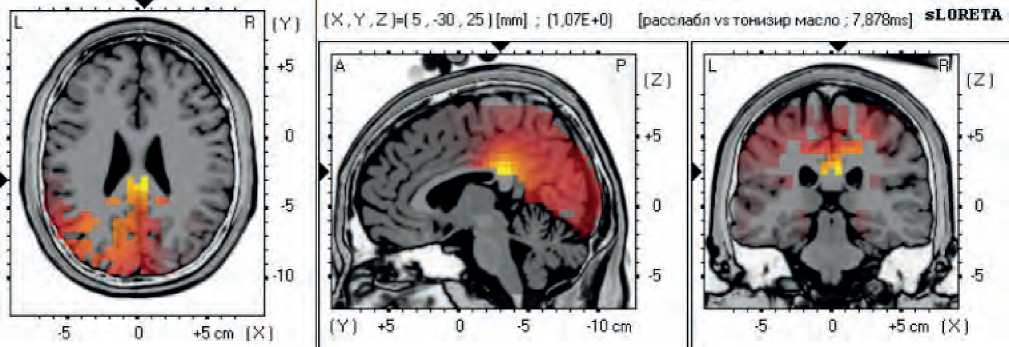
Figure 3. Difference between the relaxing and the tonic EO exposure in the alpha-2 range
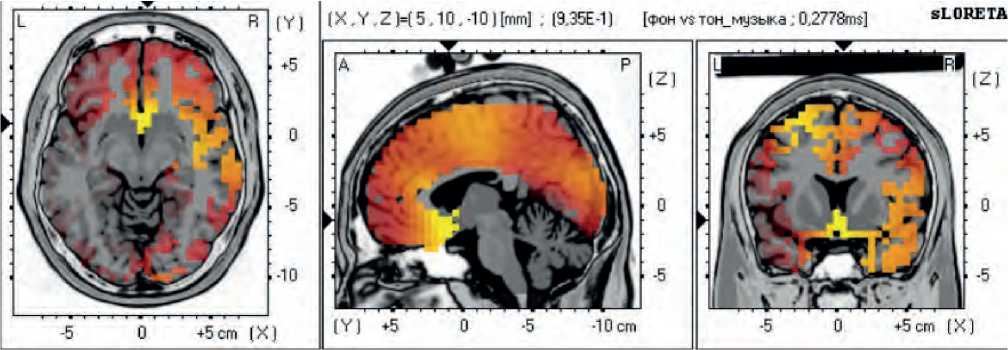
Figure 4. background EEG and tonic FM exposure in the delta range
Relaxing musical effects reliably reduce the bioelectric activity in the posterior part of the upper and middle frontal gyruses.
Interestingly that combined effects made by tonic EO and FM do not have similarities with isolated influences and are manifested in a pronounced reduction of the beta-1 activity in the left occipital region.
After the exposures, there is an activation of the deep departments of the dread area of the right hippocampus and spindle-shaped winding, which indicates the activation of the limbic system, regardless of the modality of influences.
Our results suggest both an activating and inhibitory effect on various brain pacemaker structures, mediated by the impact of tonic and relaxing sensory stimuli [2]. Particular attention should be paid to different intensity of responses to the combinations of sensory effects that might help to rank sensory influence on the objective indicators of the activation level and more objectively justify the development of the programs aimed at the psycho-emotional state correction.
At the same time, as follows from the data obtained in this study, it is possible that such a set of changes in the functional state refers to the leading mechanisms of the positive dynamics of the performance indicators in a number of sports.
4. Conclusions
The results obtained suggest that exposure to odorants can play a leading role in the modification of athletes’ functional states. The techniques designed for athlete’s psycho-emotional state control, body relaxation or activation should include the use of essential oil blends of a directed action.
We assume the presence both of activating and inhibitory influences on various pacemaker structures in the brain, including those on the nucleus of the intermediate brain, mediated by the effects of tonic and relaxing sensory stimuli.
Special attention should be paid to the different intensity of responses to combinations of sensory influences, which, possibly, will allow ranking sensory influences according to objective indicators of the
Issue 19. August 2021 | Cardiometry | 103
level of activation and more objectively substantiating programs to be designed for correcting psycho-emotional states. Our evidence data give reason to think that odorant effects can play a leading role in modifying the functional states of athletes.
The most pronounced activating effect has a tonic EO. This may be due to the anatomy-physiological features of the olfactory analyzer. Some departments of the olfactory system (the olfactory bulb, the olfactory tract, the front-centered body) are part of the limbic system. From these formations, the impulse goes to paragapocampal overwhelming, and from there to the mammarian bodies in a Papes circle. The hearing pathways do not have such specific connections with the limbic system. Possibly, it leads to a smaller effect of the isolated FM stimulation.
This is primarily due to the fact that the effects of the influence provided by music are short-lived, while the aftereffect of the exposure of essential oils is recorded at least for 30 minutes. In addition, in the mechanisms of the effect of essential oils, there is not only a change in the neurophysiological activity of the brain and the autonomic nervous system, but also the effect of odorant compounds on the neuroendocrine system, neurotransmitters and neuromodulators [2].
We have found a change in the prefrontal gyrus, the cingular gyrus activity, which is responsible for concentration and its improving. It requires further verification using coordination tests. Nonspecific activation of the limbic system with an isolated stimulus and FM, EO combinations may lead to change in the activity of the autonomic nervous system. It requires further study, taking into account an analysis of cardiovascular activity to cover blood pressure and heart rate variability.
Statement on ethical issues
Research involving people and/or animals is in full compliance with current national and international ethical standards.
Conflict of interest
None declared.
Author contributions
The authors read the ICMJE criteria for authorship and approved the final manuscript.
104 | Cardiometry | Issue 19. August 2021
Список литературы The effects of essential oils and music on the bioelectrical activity in brain
- A.T. Hayes, A. Martinoli , R.M. Goodman Distributed odor source localization. IEEE Sens, 2, 260–271 (2002).
- F.L. Angelucci et al. Physiological effect of olfactory stimuli inhalation in humans: An overview. Int. J. Cosmet. Sci, 36, 117–123 (2014).
- T. Miao et al. Plethysmogram and EEG: Effects of Music and Voice Sound. AIP Conf. Proc, 1371, 282– 289 (2011).
- D. Elliott, R. Polman, J. Taylor The effects of relaxing music for anxiety control on competitive sport anxiety. Eur. J. Sport Sci, 14, S296–S301 (2014).
- H.-S. Seo, T. Hummel Auditory-olfactory integration: congruent or pleasant sounds amplify odor pleasantness. Chem. Senses, 36, 301–309 (2011).
- W. Sayorwan et al. The effects of lavender oil inhalation on emotional states, autonomic nervous system, and brain electrical activity. J. Med. Assoc. Thail, 95, 598–606 (2012).
- V.G. Ovchinnikov, N.N. Sentyabrev, O.I. Chubatova et al. Experimental study of the principles of making essential oil blends. Modern problems of science and education, 2; URL: www.science-education.ru/116-12437 (2014).
- P. Ojha, V. Singh , A.K. Thacker Odor-induced modulation of electroencephalogram waves in healthy controls. Natl. J. Physiol. Pharm. Pharmacol, 7, 952–956 (2017).
- R.J. Pinto et al. Analysis of the Human Reaction to Odors Using Electroencephalography Responses. Proceedings of the World Congress on Engineering, 1, 243-247 (2014)
- L.D. Usanova, A.D. Usanova, and A.V.Skripal Analysis of the effect of audiovisual stimulation on EEG parameters and the propagation velocity of the pulse wave in the human. Medical equipment, 1, 26- 31, (2012).
- W. Dimpfel Classification of Herbal Drug Effects by Discriminant Analysis of Quantitative Human EEG Data // Neurosci. Med, 10, 101–117 (2019).
- K. Nagata et al. Effect of listening to music and essential oil inhalation on patients undergoing screening CT colonography: A randomized controlled trial. Eur. J. Radiol., 83, 2172–2176 (2014).
- S. Myaluk Rationale for research of the combined use of aromatherapy and music therapy to restore the athletes health. Phys.train.of students of creative spec., 3, 45-52 (2005).
- Y. Masaoka et al. Analgesia is enhanced by providing information regarding good outcomes associated with an odor: Placebo effects in aromatherapy? Evidence-based Complement. Altern. Med., 2013, 1-8 (2013).
- M. Tibo, S. Geirnaert , A. Bertrand EEG-based decoding and recognition of imagined music // bioRxiv. Cold Spring Harbor Laboratory, 2020.09.30.320176 (2020).
- K. Sowndhararajan, S. Kim Influence of Fragrances on Human Psychophysiological Activity: With Special Reference to Human Electroencephalographic Response. Sci. Pharm., 84, 724–751 (2016).
- A.-S. Crisinel, C. Spence A fruity note: crossmodal associations between odors and musical notes. Chem. Senses, 37, 151–158 (2012).
- E.K. Aydarkin, O.L. Kundupyan, D.N. Sherbina at al. Neurophysiological mechanisms of influence of rosemary and lemon balm flavors on the efficiency of complex sensorimotor response, Valeology, 4, 47-59 (2007).
- B. Saletu, P. Anderer, G.M. Saletu-Zyhlarz EEG topography and tomography (LORETA) in diagnosis and pharmacotherapy of depression. Clin. EEG Neurosci. Off. J. EEG Clin. Neurosci. Soc., 41, 203–210 (2010).
- C. Imperatori et al. Aberrant EEG functional connectivity and EEG power spectra in resting state post-traumatic stress disorder: A sLORETA study. Biol. Psychol., 102, 10–17 (2014).
- X. Gao, M. Wehr A coding transformation for temporally structured sounds within auditory cortical neurons. Neuron, 86, 292–303 (2015).
- D.A. Wilson et al. Cortical odor processing in health and disease. Progress in Brain Research., 208, 275–305 (2014).
- R. Leech, J. Smallwood The posterior cingulate cortex: Insights from structure and function. Handbook of Clinical Neurology, 73–85 (2019).
- L. Wilder et al. Decreased Neuron Density and Increased Glia Density in the Ventromedial Prefrontal Cortex (Brodmann Area 25) in Williams Syndrome. Brain Sci., 8,209(2018).

